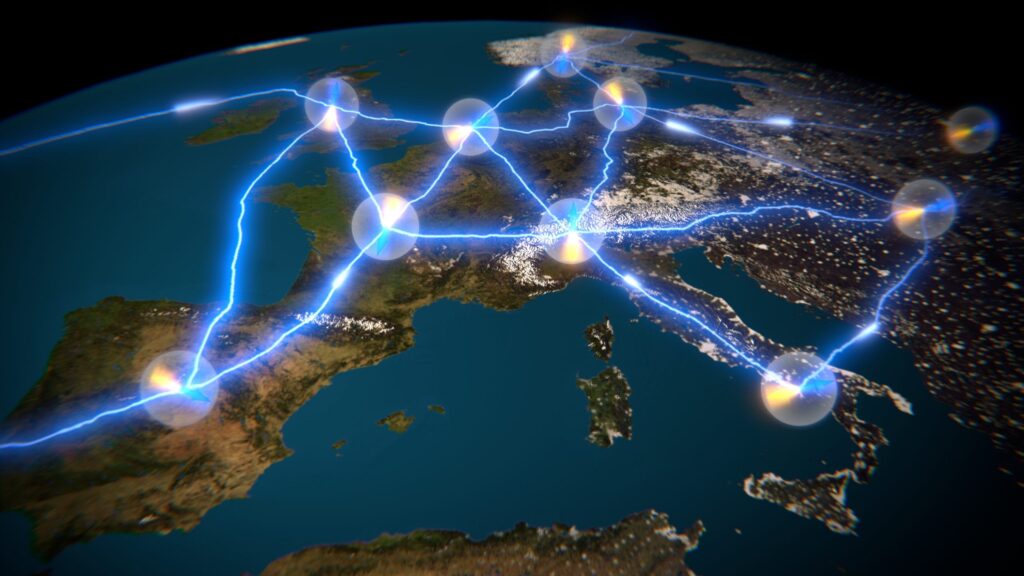Quantum Network And Quantum Internet

Quantum Network And Quantum Internet A quantum network is a system of quantum devices, such as quantum computers, quantum communication channels, and quantum sensors, connected by quantum communication links to facilitate quantum communication and distributed quantum computation. The underlying technology for a quantum network is based on the principles of quantum mechanics, particularly quantum entanglement and quantum teleportation. Quantum entanglement allows for the creation of shared quantum states between distant quantum systems, enabling quantum communication and quantum key distribution. Quantum teleportation allows for the transfer of quantum states from one quantum system to another, enabling the implementation of quantum protocols such as quantum remote state preparation and quantum network coding. The quantum internet is a vision for a global-scale quantum network that would allow for quantum communication and quantum computing on a large scale. It would be based on the development of quantum communication technologies, such as quantum key distribution, as well as the development of quantum computers and quantum sensors. The quantum internet would have applications in areas such as secure communication, distributed quantum computing, and quantum sensing. In summary, a quantum network is a system of interconnected quantum devices that enables quantum communication and computation. It is a crucial component of the vision for a global-scale quantum internet. Unfortunately, it is not yet possible to implement a full-scale quantum internet using current technology. However, some aspects of a quantum network can be demonstrated using quantum computing simulation frameworks such as Qiskit. Here is an example of using Qiskit to simulate a quantum teleportation protocol: import numpy as np from qiskit import * # initialize the quantum state to be teleported qubit = QuantumRegister(1, ‘qubit’) # create the shared entanglement between Alice and Bob entanglement = QuantumRegister(2, ‘entanglement’) # create classical registers to store measurement results c = ClassicalRegister(2, ‘c’) # create a quantum circuit with the above quantum and classical registers qc = QuantumCircuit(qubit, entanglement, c) # create the shared entanglement between Alice and Bob qc.h(entanglement[0]) qc.cx(entanglement[0], entanglement[1]) # Alice performs a Bell measurement on her qubit and one half of the entangled pair qc.cx(qubit[0], entanglement[0]) qc.h(qubit[0]) qc.measure(qubit[0], c[0]) qc.measure(entanglement[0], c[1]) # Based on the measurement result, Bob applies a correction to his qubit qc.x(entanglement[1]).c_if(c, 1) qc.z(entanglement[1]).c_if(c, 2) # Run the simulation and retrieve the results backend = Aer.get_backend(‘qasm_simulator’) job = execute(qc, backend, shots=1024) result = job.result() counts = result.get_counts(qc) # Plot the results from qiskit.visualization import plot_histogram plot_histogram(counts) This code creates a quantum circuit in Qiskit to simulate the quantum teleportation protocol. It creates a quantum register to store the qubit to be teleported, and another quantum register to store the shared entanglement between Alice and Bob, and classical registers to store the measurement results. The circuit creates the shared entanglement, performs the Bell measurement on Alice’s qubit and one-half of the entangled pair, and applies the correction to Bob’s qubit based on the measurement results. The simulation is run using the qasm_simulator backend, and the results are displayed as a histogram. This code is just a simple demonstration of the quantum teleportation protocol and does not represent a full-scale implementation of the quantum internet. However, it provides a glimpse into the kinds of quantum protocols that can be implemented on a quantum network. You may wonder what the difference is between classical and quantum internet. Well, the classical internet is a global network of computers and communication channels that allow for the exchange of information in the form of bits (0s and 1s). It is based on classical physics and uses classical communication protocols such as the Transmission Control Protocol (TCP) and the Internet Protocol (IP) to transmit data from one location to another. On the other hand, the quantum internet is a vision for a global-scale quantum network that would allow for quantum communication and quantum computing on a large scale. It would be based on the principles of quantum mechanics and use quantum communication protocols and quantum algorithms to process and transmit quantum information. There are several key differences between the classical internet and the quantum internet: Data transmission: In the classical internet, information is transmitted as bits (0s and 1s), whereas in the quantum internet, information is transmitted as quantum bits (qubits), which can exist in multiple states simultaneously. This allows for the transmission of more complex and richer forms of information in the quantum internet. Security: The classical internet is susceptible to hacking and eavesdropping, as the transmission of bits can be intercepted and altered. In the quantum internet, quantum key distribution (QKD) can be used to establish secure communication channels that cannot be eavesdropped on without being detected. Processing power: The classical internet relies on classical computers to process information, whereas the quantum internet uses quantum computers to perform computations. Quantum computers have the potential to perform certain types of computations much faster than classical computers. All in all, the quantum internet represents a future where communication and computation would be based on the principles of quantum mechanics and would offer advantages over the classical internet in terms of data transmission, security, and processing power. Facebook Twitter LinkedIn Email
